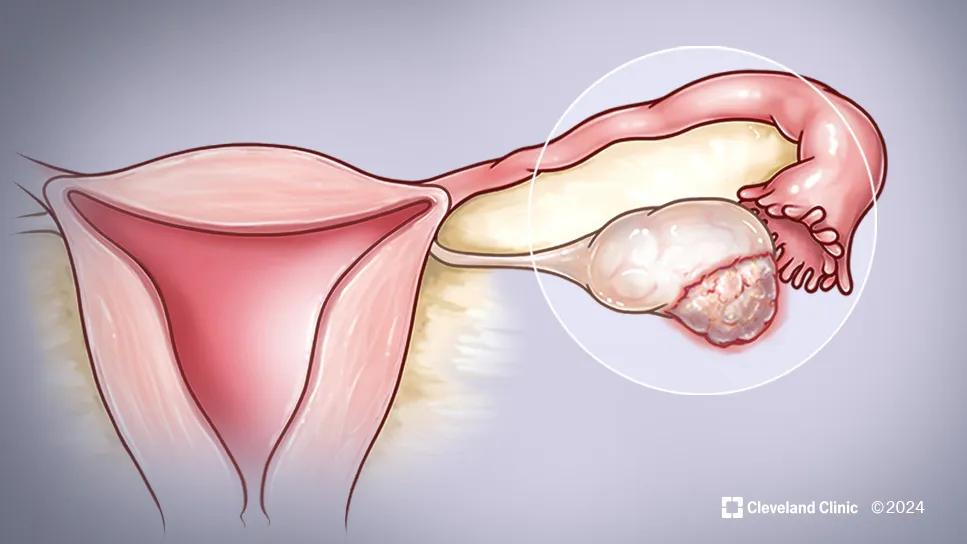Case highlights range of options for treating malignancies in pregnancy

After a pregnant woman’s routine ultrasound revealed ovarian cancer, Cleveland Clinic clinicians successfully removed the tumor and continued to provide maternal-fetal care up through the baby’s birth. A healthy boy was delivered at 37 weeks by cesarean section.
Advertisement
Cleveland Clinic is a non-profit academic medical center. Advertising on our site helps support our mission. We do not endorse non-Cleveland Clinic products or services. Policy
For this patient, good pregnancy care enabled early detection of epithelial ovarian cancer, a disease notorious for vague systems that too often allow it to go undiagnosed until it is in advanced stages. The case also presents an opportunity to address persistent misconceptions about treatment possibilities for those who are pregnant and have gynecologic malignancies.
“With cancer management during pregnancy, there are lots of things that we can do,” says Robert DeBernardo, MD, head of Gynecologic Oncology at Cleveland Clinic’s Obstetrics and Gynecologic Institute. “We diagnose pregnant women with ovarian cancer and cervical cancer. We can give chemo, perform surgery and we can do some form of imaging, which are all safe for the baby.”
Dr. DeBernardo’s patient was 28 and experiencing her first pregnancy when a routine ultrasound at 20 weeks’ gestation revealed the mass on her left ovary. A follow-up ultrasound indicated a mass of significant complexity, says Dr. Debernardo.
“It’s not uncommon to have a mass identified during a routine ultrasound, but normally it's just a functional cyst or something related to the pregnancy,” he says. “When patients have a relatively complex mass, it's more likely than not benign. In this patient’s case, family history also made us suspect cancer.”
Ovarian masses are radiologically graded either simple, with the appearance of a simple cystic lesion, or complex, which describes “literally everything else,” says Dr. DeBernardo.
“The patient’s mass was complex to the point where I did not want to wait,” he says. “We needed to manage it during her pregnancy.”
Advertisement
The tumor, ovary and fallopian tube were removed laparoscopically. Had the pregnancy been further along, laparotomy might have been required.
“Surgery is very reasonable in women who are pregnant,” says Dr. DeBernardo. “It can be done. We don't like to do it, because we have two patients at that point, and most women who are having a baby want to minimize the risk to the infant. But the anesthetic agents that we use are extraordinarily safe.”
A uterine manipulator, typically used during ovarian tumor removal, was not used in this surgery. Care is taken to avoid touching the uterus to avoid even a small chance of inducing miscarriage.
If cancer is found earlier in the pregnancy, surgeons prefer to wait until the second trimester if possible, although more advanced disease could compel earlier intervention.
In a malignancy found significantly later in pregnancy, Dr. DeBernardo noted, consideration might be given to inducing preterm labor so that the cancer can be staged and treated.
“I've cared for people who have had advanced ovarian cancer during pregnancy, and we gave them steroids to help the fetal lungs mature, then delivered a at 30 weeks. And then we do a definitive surgery. So that's another option.”
Among considerations in this case was when to perform biopsies for staging purposes.
“Staging for an ovary cancer is going to include removing the omentum, taking some peroneal biopsies, typically a lymphadenectomy, all of which can be done during pregnancy but which would've been much more challenging to do with a pregnant uterus,” says Dr. DeBernardo.
Advertisement
In this patient’s case, he felt comfortable postponing staging in part because the tumor was well differentiated. Had metastases been suspected, chemo would have been started while she was pregnant. Chemotherapy is prevailingly safe for a fetus.
Biopsies taken after the baby was born were negative, and chemotherapy was not required. The patient continues to be monitored every three month.
“Epithelial ovarian cancer at her age is really rare, and it’s definitely a very deadly disease,” says Dr. DeBernardo. “It’s fortunate that we were able to find it early.”
Advertisement
Advertisement

Two blood tests improve risk in assessment after ovarian ultrasound

Robust research focuses on detection and prevention

Researchers identify potential path to retaining chemo sensitivity

Clinical trial to assess the value of nutritional, physical therapy and social supports prior to preoperative chemotherapy

Trial examines novel approach for a disease with a high mortality rate

A well-prepared team meets the distinctive needs of patients at hereditary high risk

Reassessing antibiotic dosage and type and restoring gut biome could improve survival rates

ACOG-informed guidance considers mothers and babies